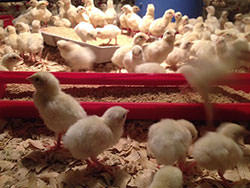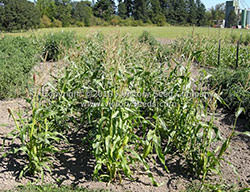Lodewyk (Wikus) Davis supervises our work at our MacFarlane Pheasants’ satellite farm in Milton, Wisconsin. He describes his primary job as “taking care of everything to do with the Milton Farm.” Technology and sound planning have increased pheasant security and helped pheasant caretakers to manage pheasant health and time management on the Milton Farm!
Smart Barn Technology Updates to the Milton Farm
This year we had a new alarm system put in the Milton barns that helps us keep track of the barn temperatures. The temperature in a barn with young chicks is critical to their health and development. The alarm system will alert us if there is a dangerous temperature change in the barn, regardless of where we are.
We will soon be adding a water alarm system to detect any water leaks inside the barn. This alarm system is called “Smart Barn,” and we will be able to use our phones to check the barns from other parts of the farm and our homes.
We have used Smart Barns at our Janesville location for some time now, so we know it works! Protecting our birds is essential. A gas or heater error or a bird hitting a water hose and flooding the barn could cause us to lose birds. Sensors that malfunction, fans that aren't working, or problems with the intake of fresh air during hot or humid conditions are all problems that will be caught immediately by our year-round alarm system. It is expensive to raise our birds, and an alarm system is well worth the expense.
Pulley System, Dwarf Corn, and Other Upgrades to the Milton Farm
We are going to add a pulley system to hoist the brooders and nipple lines in Barn A. This system will save us a lot of time. We are currently moving a ladder around to each brooder and nipple line to take care of them. We are hoping to add a feed system so that feed is added by the push of a button rather than using man-power. The man-power can then be used on other important caretaking duties on the farm.
We put a lot of time and effort into the barns to make sure the birds are healthy, and most importantly happy. Reducing any stress on our birds contributes to their health. We are a crew of 4 guys working full time on the Milton farm, but we get help from the pen crew with peeping, move-outs and catching for shipments. There is always plenty of work to do, so alarm systems give us time to get other chores done while staying alert to any dangerous situations in the barn.
We move our pheasants to outside pens at 6-7 weeks, where we continue to care for them until they are 21 weeks, when we catch them and ship them out to our customers. This year we also decided to plant our pens with dwarf corn. The dwarf corn in outside pens will save both time, and money on labor. Pulling ragweed from the nets and replacing nets and fixing holes is both expensive and time-consuming. The shorter corn provides good cover and is more convenient for the catch crew than taller varieties. “During “catching season” it will be nice to go through the pens without the cover being over our heads!”
We are excited about using the new technology at the Milton Farm to keep an eye on our chicks, even when we are not directly looking at them. Minimizing risk and having time to perfect the conditions around the farm that help our chicks grow under ideal conditions is the best possible situation! Wikus wants our blog readers to know that “the needs of our birds are our number one priority when decisions are made at MacFarlane Pheasants.”

